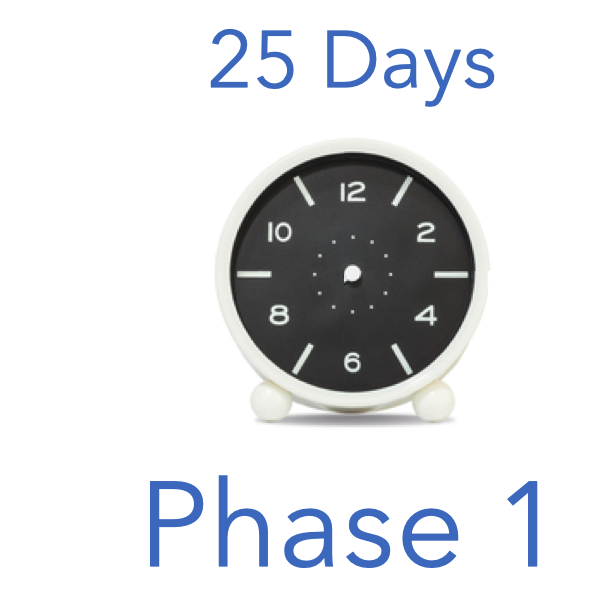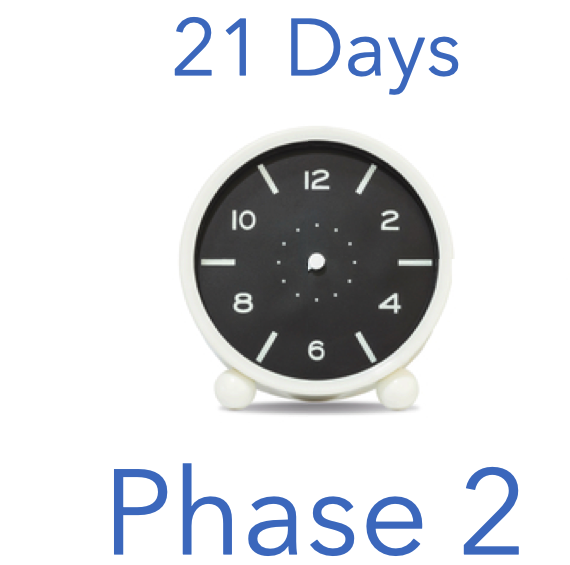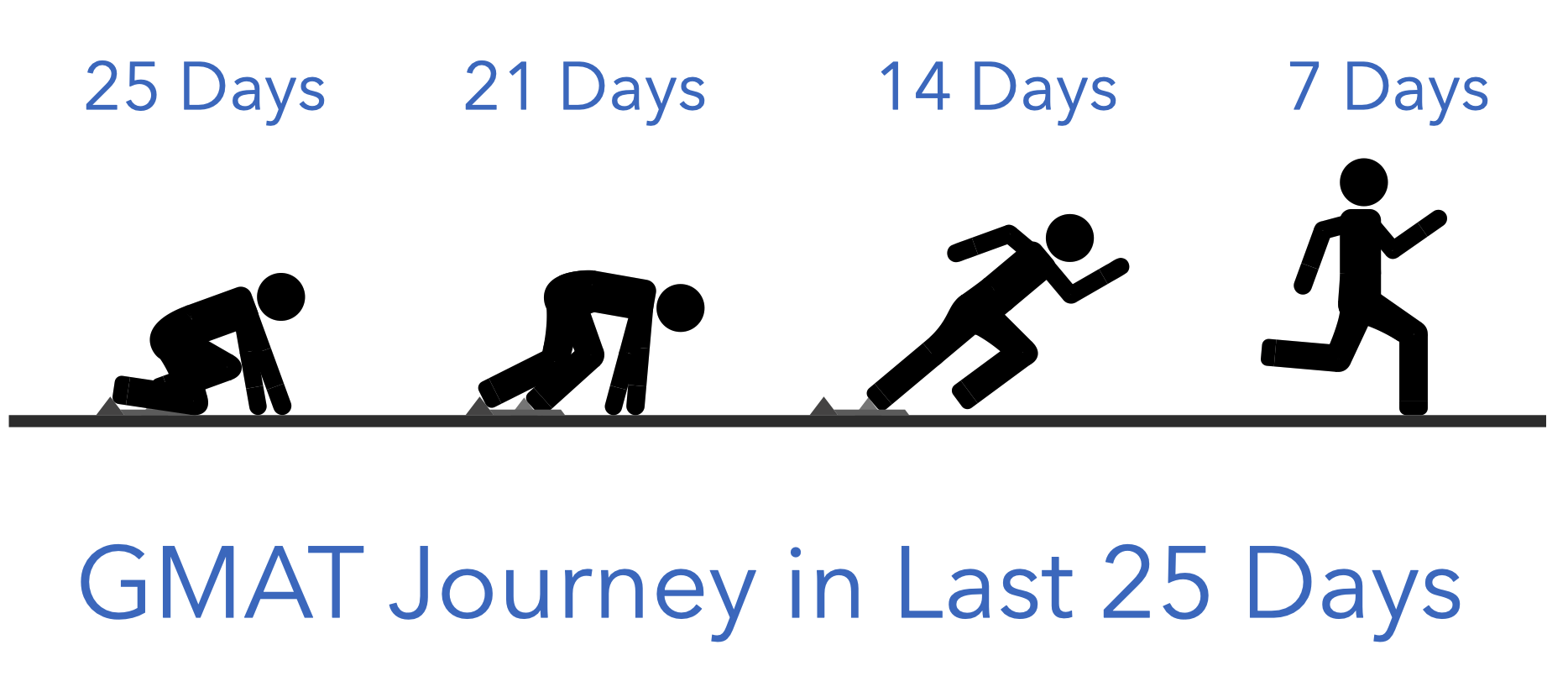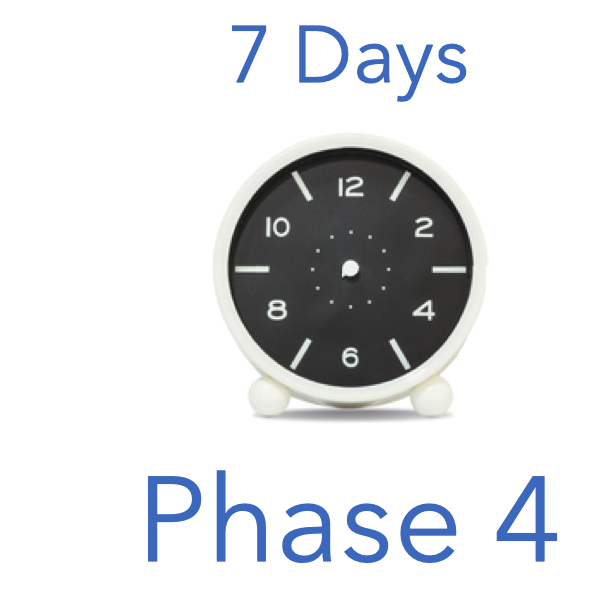Consider the following scenario – You have spent the last few weeks or months in preparing for the GMAT, and now your test date is just 25 odd days away. How should you spend this time to get the best GMAT score possible? What are the things you should and should not do so that come D-day you get the result you want? Specifically, what should your GMAT journey in the last 25 days look like?
In this article, we answer all the above as well as the following questions:
If you are planning to take the GMAT, we can help you with a personalized study plan and give you access to quality online content to prepare. Write to us at acethegmat@e-gmat.com. We are the most reviewed GMAT prep company on GMAT club with more than 2400 reviews and are the only prep company that has delivered more than 700+ scores than any other GMAT club partner. Why don’t you take a free trial and judge for yourself?
GMAT Journey – Your preparation strategy in the last 25 days
What should you focus on in these last 25 days of your GMAT journey?
Depending on the length of time you have been preparing for the GMAT, rather than learning new concepts, your focus area, at this stage, should be building your strengths and mitigating your weak areas. Last-minute cramming for a test such as the GMAT, which is focused on measuring ability, is not recommended.
Need to improve by 100+ points in 30 days?
Rhea and Bruno have done it and so can you. Read our article on 1-month study plan to learn more.
At this point in your GMAT journey, we assume you would have taken care of the following things:
- Booked your GMAT test date
- Have selected the right resources for your preparation
- Know your target subsection scores
- Maintained your error log for reviewing mistakes and identifying gap areas
- Selected the schools to which you will be sending your GMAT scores
It would be a good idea to take a mock test, even better, a GMAT Prep official mock test to get a fair estimate of where you stand. You should take the test in conditions similar to the actual exam conditions. By actual exam conditions, I mean:
- At the same time of the day as your actual test appointment
- Mimicking test center conditions – writing material and focused environment
- Take the test in a single sitting with two 8-minute breaks as provided in the actual test between sections
- Answer all 4 sections, including IR and AWA
Take a free GMAT mock to understand your baseline score and start your GMAT prep with our free trial. We are the most reviewed online GMAT Prep company with 2400+ reviews on GMATClub
The goal of the above is to simulate the test center environment and familiarize yourself as much as possible. Attempting the test in such a way will help build your test-taking stamina and condition yourself for your 3.5-hour GMAT test appointment. Also, the score that you will get on this mock test, will be a close reflection of your actual GMAT score.
Thus, the key takeaway is, that in this leg of your preparation you should focus on review and perfecting your strategy rather than trying to learn new things.
Next, we will break down the key weekly milestones you should aim to achieve in these 25 days till your actual GMAT test.
Phase 1 –  25 days before the test
25 days before the test
Focus areas:
- Attempt 1 mock test
- Perfect test-taking strategies
- Review learned concepts instead of learning new concepts
- Identify weak areas
- Maintain an error log for tracking improvement
Preparation strategy – 25 Days before the GMAT:
Since the focus of these last 25 days is to perfect your understanding and application of concepts already learned, mock tests should be given with the aim of identifying areas of improvement rather than to increase scores.
It’s very important to understand how the GMAT works as an adaptive test before you create your test day strategy. Read more.
While reviewing mock tests, you should review the solutions to both correct and incorrect responses. In the process of reviewing the correct responses, you must identify if your approach was logically correct which led to the right answer, or, was it just a lucky guess? Make note of the latter in your error log, and review the concept and application files for the topic to which the question belongs.
E.g., if you made a lucky guess on Quant in a Geometry question, revisit your concept files and attempt the application quiz. Follow up with a targeted ability quiz to build on your ability to apply the concept.

For the questions which you answered incorrectly, you must understand the reason because of which you faltered. A few reasons which may have led to the fault are:
- Lacking knowledge of the concepts required
- Inability to apply the concept
- Faltered in some step of the process to solve the question type
- e.g., if you faltered in the 3-step process to solve a PS type question.
You should note down these details in your error log. And all the learnings from your mock test attempt should be practiced upon and applied in your next mock test attempt. This will ensure you do not repeat the same mistake in your next mock test attempt, and on your actual GMAT test.
To know if you’re ready for your next mock test attempt, measure your ability levels by taking an ability quiz. If you’re hitting your target ability levels in a weak area, you may attempt the next mock test.
Using the Personalized Study Planner tool you can create a detailed, milestone-driven study plan that gives you the precise sub-sectional ability levels you need to aim for to achieve your target GMAT score. Click here to use the tool and create your own detailed GMAT Study Plan in less than 5 minutes.
Thus, reviewing mock tests in such a manner, will not only help you to build upon your strengths but also your weaknesses.
Wondering how to measure your current ability on the GMAT? Here’s an article detailing the same!
Phase 2 –  3 weeks before the test
3 weeks before the test
Focus areas:
- A complete review of the previous mock test
- Concept review and practice.
- Targeted practice to reach desired ability levels in weak sub-section per GMAT Planner.
Preparation strategy for this phase:
After you have completed the above activities, you can proceed to attempt another mock test. Make sure your attempt is under test day like conditions. Practice using the note board and earbuds provided during the actual test.
The mock test review strategy remains the same as earlier. Review your errors, maintain an error log, and target your practice towards the next set of weaknesses that you have identified.
An additional factor to consider this time around would be your sub-section timing information. You should develop your timing strategy on the basis of this timing information.
Read this article to devise your time management strategy to ace the GMAT.
Thus, to improve your score further, you should review your mock test attempt to identify which concepts to review. Additionally, devise your timing strategy on basis of your time management in the mock test.
Phase 3 – 2 weeks before the test
Focus areas:
- Covered concepts and application of concepts in weak areas.
- Perfecting timing strategy
- Last day to reschedule if not within 40 points of your target score.
Preparation strategy – 2 weeks before GMAT:
If the review and other activities associated with the previous mock test attempt are complete, you can attempt another mock test.
The focus of this mock test should be to apply your time management strategy devised earlier in this attempt. Additionally, devise your kipping strategy based on your weak areas, identified by reviewing the attempt.
Create a checklist for a review of important concepts and refer to your error log during practice to resolve errors. Make sure you are familiar with the use of note board and earplugs that are provided during the test. Also, decide your section order for the actual test based on your strong and weak sections.
Avoid falling in for these common myths related to the time management strategies!
Phase 4 – 1 week before the Test
Focus areas:
- Review checklist and error log
- Attempt another mock test
- Implement time management and skipping strategy
GMAT Preparation Strategy – Last 7 Days:
Similar to previous mock test attempts, you should fine-tune your time management and test-taking strategy in this attempt. Additionally, review your error logs, as well as checklists you have prepared for important concepts.
Make sure to view the solutions as well as the other approaches to a question which you faltered in. These will help in prioritizing your areas of focus further.
3 days before the test
Focus areas:
- Familiarise yourself with test center rules and policies
- Visit the test center to estimate travel time on test day
- Final mock test attempt
You wouldn’t want an issue as trivial as the test center to affect your performance on the test day – please ensure you take care of all the things mentioned in our article on test center facilities before booking the same.
Preparation strategy:
You should attempt one final mock test, and review your checklist and error log generated from this attempt. You should be comfortable in hitting your target score in this attempt. Go through the GMAT test tutorial to familiarise yourself with the testing interface. Additionally, you can read reviews of the test center on GMAT Club. This will make you aware of other test takers’ experiences and help you in identifying any potential issues you may face at the test center.
It would also be prudent to prepare and keep the bag that you will be carrying to the test center ready. Make sure you carry refreshments to consume during the break, as leaving the test center is not permitted. Also, carry the locally accepted form of ID. Test center administrators are permitted to refuse candidates from attempting the test if the accepted form of ID is not presented.
Watch this video on the test center check-in process at any GMAT test center.
Key takeaways:
The most important thing in the last 25 odd days of your GMAT journey is to shift your focus away from learning new material and towards reviewing the material. Spend this time wisely to develop and perfect your test day game plan. And practice the game plan during your mock test attempt.
Though business school and career goals are the eventual destinations, your GMAT journey is the first step in getting there. For important test day exam tips and a checklist read our article. As always, please write to us at acethegmat@e-gmat.com with your questions. Good luck!














